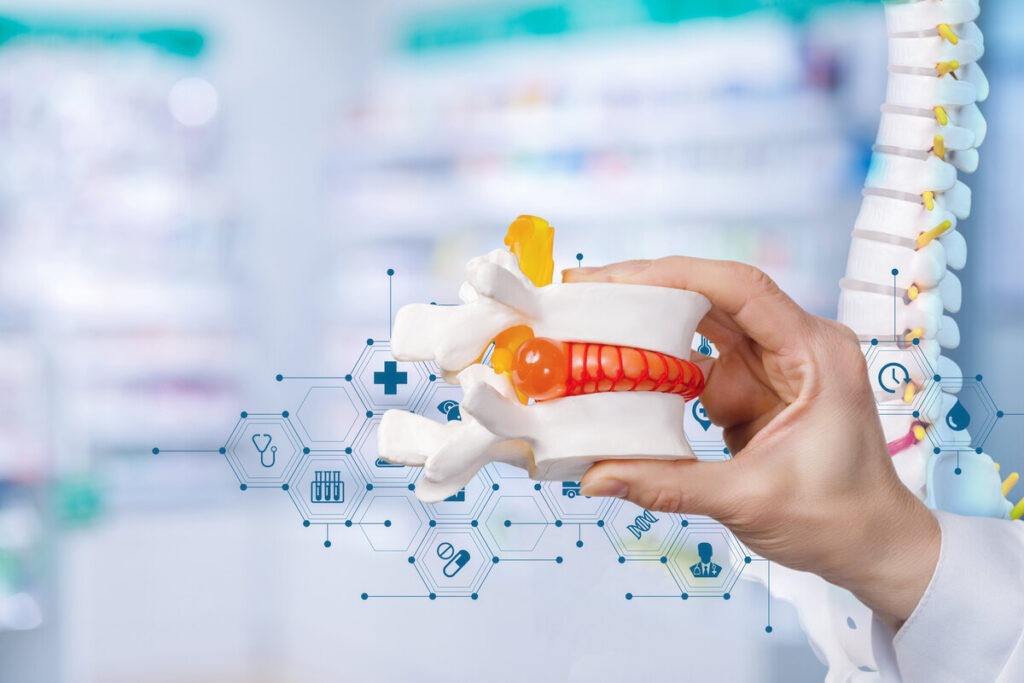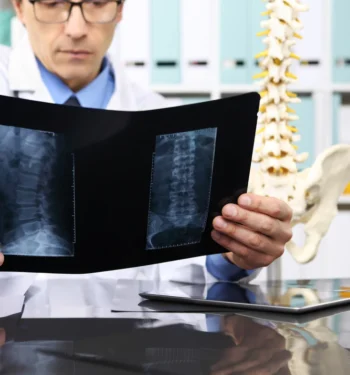
What Is the Best Surgery for a Herniated Cervical Disc?
For individuals suffering from a herniated cervical disc, several surgical options can be considered to restore function and relieve pain. Disc herniation occurs when the soft inner material of a spinal disc pushes through its tougher exterior, often causing neck pain and nerve impingement; it is a common and clinically significant cause of cervical spine symptoms. The best surgery for a herniated cervical disc is determined by the severity, precise location, symptoms, and individual patient needs. Common approaches include Anterior Cervical Discectomy and Fusion (ACDF), Artificial Cervical Disc Replacement, Posterior Cervical Decompression and Fusion, and Minimally Invasive Posterior Discectomy. These procedures are considered major surgery and, while all major surgeries carry certain risks, serious complications are rare when performed by an experienced surgeon. The optimal surgical choice for an individual patient depends on an expert assessment and a personalized Herniated Disc Treatment plan, such as those provided by the skilled team of spine specialists and surgeons at Goodman Campbell. Not everyone with a cervical herniated disc is a candidate for surgery; eligibility depends on specific clinical criteria and patient conditions.
What Is A Cervical Herniated Disc?
A herniated disc in the neck occurs when one of the discs cushioning the cervical spine’s vertebrae becomes damaged or displaced, potentially compressing nearby nerves. During this process, the nucleus pulposus—the soft inner core of the disc—can protrude through the annulus fibrosus, leading to nerve compression. These injuries often arise at the C5-C6 level, which is especially prone to degeneration due to cervical disc disease, a common underlying cause.
What Are Common Symptoms Of A Cervical Herniated Disc?
Common symptoms include persistent neck pain, radiating arm pain or numbness, tingling, muscle weakness, and, in severe cases, problems with grip strength or coordination.
Is a Bulging Disc in the Neck a Serious Condition?
A bulging or herniated disc in the neck can be serious, especially if it results from injury or trauma, and may lead to nerve compression, spinal cord involvement, or progressive neurological symptoms.
Trauma is a common cause of acute cervical disc herniation and may require urgent evaluation. Persistent or worsening symptoms, such as loss of arm strength, difficulty with coordination, or severe pain, signal the need for prompt medical attention.
At Goodman Campbell, our experienced physicians help you determine the seriousness of your condition through compassionate evaluation and advanced diagnostics.
Test for Herniated Disc in Neck
Diagnosis starts with a detailed medical history and neurological examination. Imaging tests, such as MRI or CT scans, are often necessary to visualize the exact location and severity of the herniated cervical disc. In some cases, nerve conduction studies or electromyography may be recommended to evaluate nerve function more closely, and these tests are often used to confirm cervical radiculopathy.
What Are The Primary Surgical Options for a Herniated Disc?
Anterior Cervical Discectomy and Fusion (ACDF): ACDF is a widely used surgery where the damaged disc is removed from the front of the neck using an anterior approach, relieving compression, and the adjacent vertebrae are fused together for stability. This method is trusted for its excellent track record in resolving pain and neurological deficits. Spinal fusion and spinal fusion surgery eliminate motion at the affected disc space, but may reduce neck mobility compared to other options. The neural foramen, where nerve roots exit the spinal canal, is a key anatomical area targeted for nerve decompression during this procedure. Several distinct surgeon approaches exist for treating cervical disc issues, depending on the patient’s condition and anatomy:
Artificial Cervical Disc Replacement
For eligible patients, disc replacement offers a motion-preserving alternative to fusion. The affected disc is removed and replaced with an artificial disc, which mimics the function of a natural disc, maintaining more natural neck movement — a significant benefit for active individuals.
Posterior Cervical Decompression and Fusion
When a herniated disc compresses the spinal cord or nerve roots from the back, a posterior approach may be indicated. This is a type of posterior cervical spine surgery. The surgery relieves pressure and stabilizes the cervical spine with a fusion and is often used for complex or multi-level disease. The neural foramen is also targeted for nerve decompression in this procedure.
Minimally Invasive Posterior Discectomy
For select cases, minimally invasive posterior discectomy can remove portions of the herniated disk material through smaller incisions, causing less muscle damage and often allowing for faster recovery.
Different surgical approaches, such as anterior and posterior, are chosen based on the location of the herniation.
Choosing the Best Spine Surgery For Herniated Disc Option Based on Disc Location, Severity, and Patient Needs
No single procedure is right for every patient. Factors your care team should consider when recommending surgery include the specific vertebra involved in the herniated disc (e.g., C5-C6 vertebra), the degree of nerve or spinal cord involvement, and whether there is severe compression, which may require more urgent or extensive intervention. Other considerations include the number of discs affected and the patient’s age, overall health, and lifestyle needs. The Goodman Campbell team consists of spine specialists, as opposed to generalists, who work closely with you to develop an individualized care plan focused on achieving the highest quality outcomes.
What Is the Best Surgery for the C5, C6, and C7 Neck?
The C5, C6, and C7 vertebrae are crucial areas in the cervical spine, often affected when herniated discs at these levels cause significant pain or neurological symptoms. Surgery for these levels typically involves removing the damaged disc to relieve pressure on nerves and the spinal cord. The spinal canal, which serves as the protective passageway for the spinal cord within the vertebral column, can also be affected by herniated discs, leading to nerve compression and neurological deficits.
The most common surgeries include Anterior Cervical Decompression and Fusion (ACDF), artificial cervical disc replacement, and, in select cases, minimally invasive procedures.
Anatomy of the Cervical Spine: Focus on C5, C6, and C7
These vertebrae sit at the lower part of your neck and play an essential role in supporting your head, allowing neck movement, and enabling nerve signals to travel from your brain to your arms and hands. The spinal nerves that exit the cervical spine at these levels are responsible for transmitting these signals, and any impingement or damage to these spinal nerves can affect sensation and movement in the arms and hands. A herniated or bulging disc at these levels can press on nearby nerves or the spinal cord, leading to troubling symptoms such as neck pain, radiating arm pain, weakness, or numbness. Understanding the anatomy empowers patients and families to be active participants in their care and can help you better understand the purpose behind targeted treatments. Expect your spine care team to be willing to thoroughly answer any questions or concerns you have about any step in your care.
Common Surgical Procedures for C5, C6, and C7 Vertabrae
At Goodman Campbell, experienced surgeons most frequently recommend the following procedures for herniation at these levels:
- Anterior Cervical Decompression and Fusion (ACDF): The damaged disc is removed through a small incision in the front of the neck. The space is filled with a graft and stabilized with a plate and screws, helping bones fuse over time. Surgeons’ expertise in this procedure is crucial for optimal outcomes and postoperative care.
- Artificial Cervical Disc Replacement: In cases where preserving motion is a top priority, the damaged disc is removed and replaced with an artificial one, allowing for more natural neck movement post-surgery. Surgeons carefully select candidates and utilize advanced surgical techniques to ensure the best possible results.
- Minimally Invasive Posterior Discectomy: For appropriate cases, this procedure uses smaller incisions from the back and specialized tools to remove the herniated portion, resulting in faster recovery and less tissue disruption. The recovery time for minimally invasive posterior discectomy is typically shorter compared to traditional open approaches, allowing patients to return to normal activities sooner.
What to Expect During Surgery at C5, C6, and C7
Your safety, comfort, and long-term outcomes are the priorities at Goodman Campbell. Most surgeries at these levels are performed under general anesthesia. Potential risks of the procedure include bleeding, infection, and allergic reactions to anesthesia. Specialized neurosurgeons and support staff guide you through every step — from pre-op planning and imaging to the operating room, and into your initial recovery. Many patients experience immediate relief from nerve symptoms, and, depending on the procedure, the hospital stay might be as short as 1–2 days, or performed as an outpatient procedure. Our compassionate team walks with you each step to answer questions, manage pain, and provide rehabilitation guidance for the best possible recovery.
Factors Influencing Your Procedure Choice
Several factors determine which procedure is best for the C5, C6, or C7 levels: the size and position of the herniation, degree of nerve compression, your general health, and whether preserving motion or achieving solid fusion is most important for your lifestyle. Goodman Campbell tailors treatment recommendations for each person, combining advanced diagnostics with a holistic understanding of your needs and goals.
Cervical Herniated Disc Surgery Cost
Insurance coverage, hospital fees, and the type of procedure all impact cervical herniated disc surgery costs. The Goodman Campbell team works closely with you and your insurance provider to clarify financial considerations, so you can focus on healing. We believe peace of mind about cost is a vital part of your care journey, and transparent communication is a hallmark of our promise to you. Request an appointment to get started.
How Long Does It Take To Recover From Neck Surgery C2, C3, C4, C5, C6, C7?
Recovery from neck surgery — particularly at levels C2 through C7 — varies by the type of procedure, individual patient factors, and the severity of the initial condition. Certain milestones in recovery, such as collar immobilization or medication regimens, may last for a specific period, such as a one-week or two-week duration. Most patients can expect a recovery period ranging from several weeks to several months, with many returning to work and daily activities within 4–6 weeks, but full healing and restoration of function may take up to a year. Goodman Campbell supports patients every step of the way, emphasizing open communication to ensure your recovery is as smooth and comfortable as possible.
Typical Recovery Timeline for Cervical Spine Surgery
The recovery journey after cervical spine surgery performed as an inpatient procedure, usually starts with a short hospital stay — sometimes just 1–3 days. Cervical spine surgery can also be completed on an outpatient basis, depending on whether the surgery was completed using traditional or minimally invasive techniques, along with other factors. During this time, your care team at Goodman Campbell will closely monitor you for comfort, mobility, and safety. Pain is typically managed through medication and supportive devices, and early movement is encouraged to reduce the risk of complications. A comprehensive pain management plan may also be implemented, which can include non-surgical approaches such as physical therapy and referrals to pain specialists to help manage symptoms effectively.
After surgery, patients are discharged home with instructions regarding wound care, medication, and gradual increases in activity. It is common to experience some initial stiffness in the neck, mild swallowing difficulties, or fatigue, but these usually improve daily. Within 4–6 weeks, patients typically feel significant relief from pre-surgical symptoms, and many can resume light activities and return to desk jobs, depending on their neurosurgeon’s guidance.
Stages of Recovery: Hospital Stay, At-Home Care, and Returning to Activities
During the first few weeks at home, focus is placed on rest, walking, and gentle neck movements. Physical therapy may be introduced to accelerate healing, improve flexibility, and rebuild strength. Your Goodman Campbell care team provides resources and education tailored to your procedure and specific needs, empowering you to progress at your own pace.
Between one and three months after surgery, most patients see a return to many normal routines, though high-impact or strenuous activities are typically postponed until imaging confirms solid bone healing or successful device integration. Your recovery plan is uniquely designed to help you regain independence and confidence while always being mindful of your comfort and safety.
Tips for Optimal Recovery and Minimizing Complications
Optimal neck surgery recovery is a partnership between you and your medical team. Following post-operative instructions closely, keeping follow-up appointments, and promptly reporting any new or worsening symptoms are critical steps. Smoking cessation, balanced nutrition, and adequate hydration further support your body’s natural healing process.
Potential Long-Term Outcomes and Effects Post-Surgery
With the progressive, expert care provided at Goodman Campbell, most patients experience lasting relief from the symptoms of a bulging disc in the neck, including pain, weakness, and numbness. In the vast majority of cases, patients regain function and return to a fulfilling, active life without significant limitations. There may be occasional long-term effects, such as restricted neck mobility (especially after fusion) or mild discomfort, but these scenarios are uncommon with today’s advanced surgical techniques.
Facing the decision to have neck surgery is never easy, but know that you are not alone. The team at Goodman Campbell is honored to walk beside you, providing encouragement, expertise, and hope for a healthy, vibrant future. Request an appointment to get started.
What Is The Success Rate Of Cervical Herniated Disc Surgery?
Cervical herniated disc surgery offers a high success rate for relieving pain, restoring mobility, and improving quality of life for many patients facing debilitating neck and arm symptoms. However, surgery is typically considered only after nonsurgical treatments, such as physical therapy, medication, and steroid injections, have not provided sufficient relief. Conservative treatment and non surgical treatments—including immobilization, traction, pharmacotherapy, and minimally invasive procedures—are often effective for many patients, and surgery is reserved for those who do not respond. Most modern surgical techniques have proven to be highly effective, with published medical studies reporting that approximately 85-95% of patients experience significant or complete relief from their symptoms. These outcomes empower patients to reclaim their independence, return to cherished activities, and enjoy a fuller life, often within just a few months of their procedure.
What determines the success rate of cervical herniated disc surgery?
Multiple factors influence the herniated disc neck surgery success rate, such as the patient’s age, overall health, the severity and duration of symptoms, and the particular surgical procedure chosen. Procedures like Anterior Cervical Discectomy and Fusion (ACDF) and Artificial Cervical Disc Replacement consistently show high levels of long-term effectiveness, but individual outcomes may vary. Patients who address their symptoms early, before extensive nerve damage sets in, tend to have even better outcomes and lower risks of persistent complications.
How does surgery improve symptoms and daily life?
Surgical intervention typically provides marked relief from neck and arm pain, as well as improvements in hand strength, coordination, and overall functional ability. Studies report that most patients return to their daily routines, sports, or work within a few weeks to a few months, depending on the complexity of their surgery and initial health status. Patient satisfaction rates are encouragingly high—patients often share stories of regaining the ability to hold their loved ones’ hands, return to hobbies, and sleep comfortably again after surgery.
What long-term outcomes and satisfaction can I expect?
The primary goal of cervical disc surgery remains to relieve pressure on the spinal cord and nerves, stopping ongoing damage and preventing worsening symptoms. With highly skilled neurosurgeons and state-of-the-art technology, long-term outcomes are overwhelmingly positive. Research shows over 90% of patients are satisfied with their results, and the majority can enjoy a renewed sense of wellbeing, confidence, and active participation in life. Ongoing physical therapy and a healthy lifestyle can further boost and preserve these wonderful gains.
At Goodman Campbell, we’re inspired by every patient’s courage and resilience through their healing journey. Our compassionate team is dedicated to delivering leading-edge surgical care and ongoing support. Take the first step in getting expert treatment in Indiana for your herniated disc by requesting an appointment.


